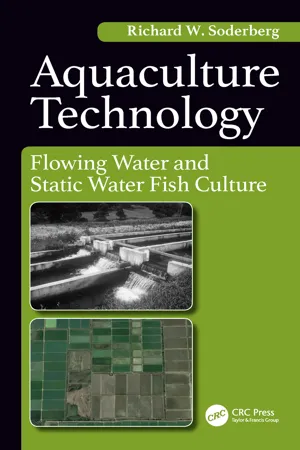
- 272 pages
- English
- ePUB (mobile friendly)
- Available on iOS & Android
About this book
Key features:
- Takes a quantitative approach to the science of aquaculture
- Covers the complete landscape of the scientific basis of fish culture
- Promotes problem solving and critical thinking
- Includes sample problems at the end of most chapters
- Guides the reader through the technical considerations of intensive aquaculture, including fish growth rates, hydraulic characteristics of fish rearing units, oxygen consumption rates in relation to oxygen solubility and fish tolerance of hypoxia, and water reconditioning by reaeration and ammonia filtration.
- Discusses the environmental effects of aquaculture
- Includes a chapter on hatchery effluent control to meet receiving water discharge criteria
Aquaculture Technology: Flowing Water and Static Water Fish Culture is the first book to provide the skills to raise fish in both a flowing water and a static water aquaculture system with a pragmatic and quantitative approach. Following in the tradition of the author's highly praised book, Flowing Water Fish Culture, this work will stand out as one that makes the reader understand the theory of each type of aquaculture system; it will teach the user "how to think" rather than "what to think" about these systems.
The book presents the scientific basis for the controlled husbandry of fish, whether it be in a stream of water or a standing water pool. Part 1, Flowing Water Fish Culture, is a major revision of the author's initial book and includes greatly expanded coverage of rearing unit design criteria, fish growth and the use of liquid oxygen, hatchery effluent control, and recirculating systems. Part 2, Static Water Fish Culture, presents the scientific basis of fish culture in standing water systems including nutrient and dissolved gas dynamics, pond ecology, effects of fertilization and supplemental feeding, water quality management and representative static water aquacultures.
Aquaculture Technology conveys the science in a manner appropriate for use by university students and teachers and others involved in fish production and aquaculture research and development worldwide. It will enable the reader to adapt to changing technologies, markets, and environmental regulations as they occur.
Frequently asked questions
- Essential is ideal for learners and professionals who enjoy exploring a wide range of subjects. Access the Essential Library with 800,000+ trusted titles and best-sellers across business, personal growth, and the humanities. Includes unlimited reading time and Standard Read Aloud voice.
- Complete: Perfect for advanced learners and researchers needing full, unrestricted access. Unlock 1.4M+ books across hundreds of subjects, including academic and specialized titles. The Complete Plan also includes advanced features like Premium Read Aloud and Research Assistant.
Please note we cannot support devices running on iOS 13 and Android 7 or earlier. Learn more about using the app.
Information
Table of contents
- Cover
- Half Title
- Title Page
- Copyright Page
- Contents
- Preface
- Section I: Flowing water fish culture
- Section II: Static water fish culture
- Appendix: Solutions to sample problems
- Index